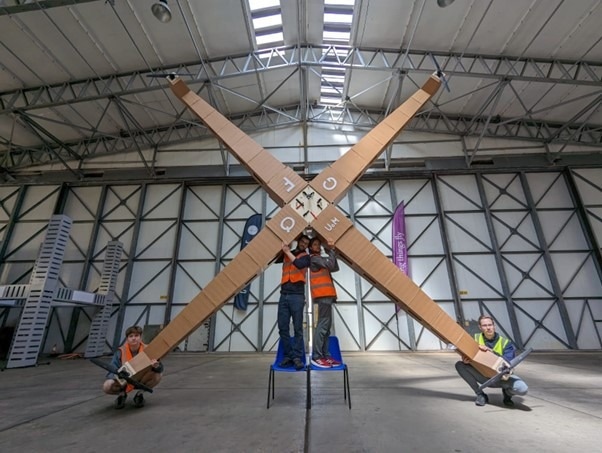The world’s largest quadcopter drone has been designed and successfully flown by engineers from The University of Manchester.
 Quadcopter. Image Credit: The University of Manchester
Quadcopter. Image Credit: The University of Manchester
The drone, constructed from a foamboard-like material, spans 6.4 meters (21 feet) from corner to corner and boasts a weight of 24.5 kg–just half a kilogram under the weight limit established by the Civil Aviation Authority.
The groundbreaking design of this drone, known as the Giant Foamboard Quadcopter (GFQ), sets it apart from all others currently in existence. Its four arms consist of a series of hollow box structures that can be conveniently detached for transport.
As of the time of writing, there is no documented instance of a purpose-built uncrewed quadcopter with four rotors, regardless of its weight class, that surpasses the size of the Manchester vehicle.
Initially, this attempt began as a curiosity-fueled initiative aimed at igniting the imaginative flair of students in design. It sought to explore a viable, eco-friendly, and cost-effective substitute material for lightweight aerospace structures, in stark contrast to the conventional choice of carbon fiber.
Unlike carbon fiber, materials composed of low-density sheets possess a remarkable potential for recycling and even composting. The researchers anticipate that this showcase will serve as an inspiration, encouraging the emerging generation of designers to adopt an entirely fresh outlook on sustainability.
Foamboard is an interesting material to work with, used in the right way we can create complex aerospace structures where every component is designed to be only as strong as it needs to be - there is no room for over-engineering here.
Dan Koning, Research Engineer, The University of Manchester
Koning added, “Thanks to this design discipline and after extensive background research, we can say with confidence that we have built the largest quadcopter drone in the world.”
Koning headed the design and build of the vehicle.
While this quadcopter was originally created solely as a proof-of-concept exercise, potential future iterations of this vehicle type could be tailored to transport substantial payloads across short distances or serve as a drone “mothership” for air-to-air docking experiments.
The quadcopter’s construction involved assembling sheets of 5mm thick foamboard, which combines a foam core with a paper skin, meticulously cut to size using laser technology and then meticulously assembled into the 3D structure by hand, utilizing solely hot melt glue.
It is worth noting that Josh Bixler, a globally renowned YouTuber and a pioneer in remote-controlled aviation, holds the position of President at Flite Test, the company responsible for producing the foamboard employed in the creation of the GFQ.
Commenting on the work, Josh stated, “So many times aircraft with advanced features are made of costly materials and we truly believe they don’t have to be. Seeing engineers push the limits in such an approachable, yet extravagant way was inspirational and showed that they were truly thinking outside of the box.”
The GFQ is equipped with four electric motors fueled by a 50-volt battery pack, alongside an integrated onboard flight control system that enables autonomous flight.
Its first flight occurred on July 5, 2023, within the primary hangar of the Snowdonia Aerospace Centre. This event transpired during the CASCADE Collaboration Workshop Week, where teams from diverse universities across the United Kingdom convened to showcase their cutting-edge research technologies and engage in collaborative innovation discussions.
The first moments of flight are the make-or-break point for these types of multi-copter drones. There are many hundreds of things that you must get right. If everything has been designed and built well, we expect success, but any problems will become very apparent in a rapid unscheduled disassembly on the first take-off.
Kieran Wood, Lecturer, Aerospace Systems, The University of Manchester
This project extends the achievements of a similarly sized fixed-wing foamboard aircraft in 2022. Subsequently, a dedicated student organization was established at the University with a primary mission of advancing the development of lightweight, large-scale foamboard Unmanned Aerial Vehicles (UAVs).
In the past year, a group of undergraduate students played a pivotal role in constructing and evaluating several vital sub-components of the aircraft’s structure.
Bill Crowther, a Professor of Aerospace Engineering at The University of Manchester, stated, “Working with foamboard provides a unique learning opportunity for students to experiment with innovative structural designs.”
Crowther added, “Although the material is strong for its weight, it requires significant engineering skill to exploit its structural potential. Ultimately, with this design you are holding up 25kg of aircraft with just a few strategically placed pieces of paper-that’s the art of the possible.”
Currently, the research group is looking to improve the design of the Giant Foamboard Quadcopter further.
The lessons we’ve learned from this pathfinder vehicle should help us add a few more meters to the next one. But to go 50% bigger, you’ve got to get 100% smarter.
Dan Koning, Research Engineer, The University of Manchester